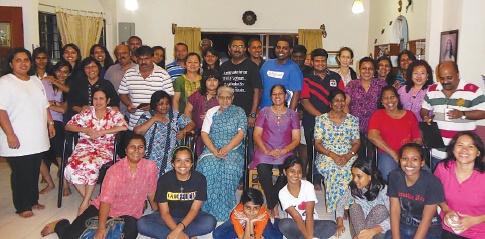For what is the BEC?
In light of BECs being the core need of the Peninsular Malaysia Church, we are dedicating this page to report on the BECs.
Dec 22, 2017

The BEC is the option to renew the Church from the grassroots level, from the faith of a believing people and from Jesus and his Spirit.
This new figure, the “face” of the Church, is revealed little by little. But it is precisely at the grassroots level and from here that this incarnation takes place, where this manner of being the Church develops. It is also at this level that a new theological reflection begins to take shape, being more rooted and adapted to today’s lifestyle.
What we present is the ideal of what a BEC should be. It doesn’t matter if some BECa are not able to realise this ideal from the very beginning. What counts is that we know in what direction we should be heading in order to properly orient our efforts. That is why it has to be taken for granted that there will be great pluralism in the shaping of the BEC. The more incarnated they are in the social medium, faithful to the people of that environment, then the more “particular” will be the BEC with an originality and personality all their own. The more they emphasise one or other aspect or dimension, the more different they will appear.
As the Church, the BEC is the visible, efficient, sacramental mediator of communion with God (adhesion to Christ) with others and with history.
-- What is the face of Christ in your BEC?
-- It makes manifest that without a radical communion with God through Jesus Christ, any other form of purely human communion results, in the long run, incapable of sustaining itself and ends up fatally turning against the person itself.
-- The human person lives his/her fraternal vocation in the heart of the local Church in communities that make present and operative the salvific design of the Lord, lived in communion and participation.
-- The marvellous gift of new life is lived in an excellent way in the small communities”
-- BEC. . . solidarity and commitment to the new commandment of the Lord (love one another)
-- Each ecclesial community should strive to be an example for the continent of a way of living together where freedom and solidarity are integrated.
-- The BEC .., creates greater interpersonal relationships.
-- In the BEC, it is made possible at the existential level an intense experience of the face of the Church as the Family of God The BEC ... communion in smaller units.
-- The BEC should respond to the deeplyfelt desires and unresolved questions. . of fellowship
In its very organisation, the Church should project to the world visible and intelligible sign of this communion of filial relationship, of fraternity and stewardship. In other words, the reality that the Church is the mystery of this communion between persons cannot be reduced to a simple intellectual affirmation without any repercussions in the reality of daily life. This presence of God becomes a sign that should lead to the reciprocal commitment in truth and in justice.
A community that celebrates the faith
The BEC leads to the participation in the Eucharist.
-- Is responsible for worship (as an expression of the faith).
The BEC is the proof of... the participation (of the laity) in the liturgical assemblies and in apostolic works.
-- Many Christian communities that lack an ordained, minister accompany and celebrate the events and festivities with gatherings of prayer and song which at the same time evangelise the community and provide it with evangelical force.
-- The BEC in their programmes of evangelisation integrate personal and communal prayer.
-- Our ecclesial communities respond to the desire and suggestions … of active missionary liturgical participation
Faith is being lived in a new historical experience
Gathered together in Jesus Christ, the BEC makes use of all the varied possibilites of the expressions of faith and of the existing Christian devotions.
It seeks to interpret the authentic intuitions, respecting the positive aspects, providing an opportunity for participation and helping to overcome the ambiguities of religious syncretism.
‘The content for the celebration — of that which is going to he celebrated — is not as before, predetermined and the same for all places, but rather it is chosen by the community. She celebrates life, events, successes. The celebrations vary therefore, according to the communities of the periphery, in the city, in the country, in the fishing villages, or the agricultural field. Importance is given to the topics of life. One celebrates the struggle against the contamination of the waters, birth of a child or the sickness or death of a sister; one celebrates the time for planting or the time for reaping. Each celebration is prepared. There are a few general norms. The main element is the reading of the Word of God. There is song, shared reflection, the prayer of the faithful. There is a good deal of creativity”.
As can be verified by these experiences (already quite widespread in the BEC) the celebration of the faith is in keeping with the concrete reality experienced in the BEC. The events, the people, the joys, the efforts, the sufferings and the shared life are all matters for prayer. The very reality becomes a place for prayer. The BEC experiences the sacramentalization of concrete liberations and experiences of communion. The Christians are helped to discover God not only in harmony with the world but also in its contradictions, conflicts and underdevelopment. This new experience of God expressed in the life and celebrations of the BEC comes about precisely because the faith is being lived in a new historical experience.
The Eucharist is certainly one way of coming together to pray. However, for circumstantial reasons. the Eucharist cannot be celebrated frequently because the priest is not permanently present in the BEC. The community ought to try and have the Eucharist from time to time. In the meanwhile, they share in and receive communion which is sent from the parish centre.
Besides the Eucharist, the community has at its disposition many other means of praying: the prayer of praise, spending time to remember the wonders that the Lord has wrought; prayer of penance. The community of faith is also a community of sinners and experience has shown that it is positive that at certain periods the BEC dedicates a special moment to the celebration of penance even if it has to be done without a priest. This ceremony can have a theme (family life, neighbourhood, professional life). To experience conversion and reconciliation in community is educational and life-giving for the faithful.
There is also the prayer of intercession. Sometimes the prayer of the community has no other end other than to pray for all those for whom the community is responsible — the members of the community and its difficulties.
Whatever the type of prayer that is proposed, it is a good idea to introduce it and explain it briefly at the beginning of the session.
Source: Basic Ecclesial Community: Church from the Roots By Jose Marians and Team, (National Biblical Catechetical and Liturgical Centre, Bangalore, India)







Total Comments:1